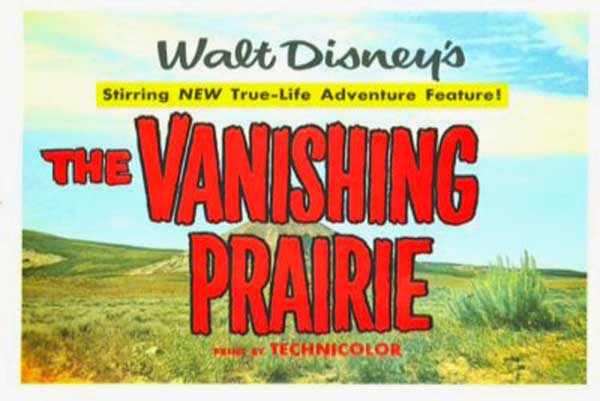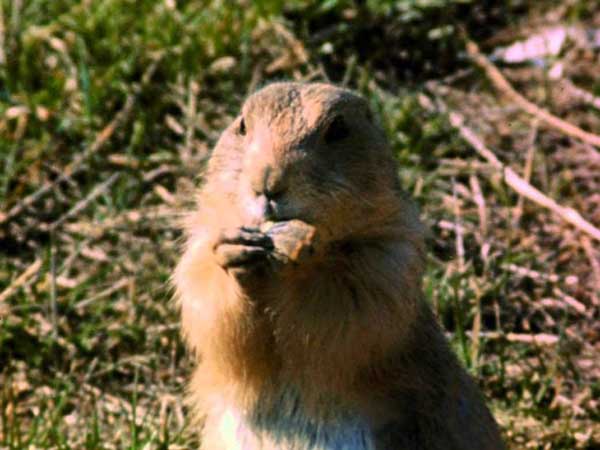When I spoke with Christian Moran about Walt Disney’s True-Life Adventures on The Tomorrow Society Podcast, I mentioned my lack of experience with that film series. There are a few exceptions, however. Back in 2015, I wrote about The Vanishing Prairie on my film blog when it aired as part of TCM’s “Treasures from the Disney Vault” special. This 1954 release won the Academy Award for Best Documentary Feature and was the series’ ninth film. I’ve published a modified version of it here since it connects to the recent podcast and Moran’s book.
The Vanishing Prairie begins on an animated map of North America as a paint brush reveals the country’s natural features, particularly grassland in the middle. Narrator Winston Hiller gives a matter-of-fact description of those features and sets the stage. His delivery resembles a guy like Peter Coyote, who is distinctive but fails to distract from the action. The tone may feel slow to modern audiences. One reason is less wonder today at close views of animals; we’re spoiled by cable networks and sophisticated zoos. Even so, it’s hard not to find solace in the intimate view of hundreds of birds migrating towards the Arctic tundra.
A key factor in selling the charms of the prairie is Paul Smith’s music, which presents everything as a magical event. Ducks walking in slow motion? That’s amazing! There’s an operatic feeling to the presentation, especially when animals graze as a group. It feels like they’re dancing to the music, aided by frequent slow motion. The choices are designed to evoke strong emotions. Ominous music plays when a rattlesnake arrives, while a happy tune shows the cuddly prairie dogs. There’s danger in making the natural world feel too sentimental, and more cynical viewers won’t enjoy the simplified connections to school and recess designed to engage kids.
Connecting Nature to Our Lives
The challenge with The Vanishing Prairie is how much the animals are viewed through an anthropomorphic lens. Hiller calls the ducks “mother” and “father” and makes countless quips like this one: “I declare these husbands, always leaving things for someone else to pick up.” This approach makes sense, yet it feels like too much. The constant references to mothers taking care of their babies cheapen the striking images. A remarkable moment depicts a buffalo immediately acting to save her suffocating baby after its birth. This scene works on its own and doesn’t need an obvious reference to our lives. This style is still used frequently today, so it isn’t confined to Disney in the ‘50s. March of the Penguins earned huge crowds in 2005 with similar tactics.
Despite those issues, there’s enough cool footage to make it worthwhile. Long shots of the buffalo as dots in the distance are gorgeous and sell the prairie’s beauty. Watching the pronghorn antelope sprint across the plain is thrilling; the camera can barely keep up with them. There are also tense moments of hunting, especially with the mountain lion. The matter-of-fact look at hunting a deer shows the importance of the circle of life. Another incredible shot reveals a fawn hiding within the brush while a lion walks across the log above it. These scenes don’t pander and offer interesting details about how both predator and prey thrive.
Resonance Today
The title The Vanishing Prairie implies a greater focus on what we’re losing in our natural world. It mentions some examples, including decreases for the whooping crane and buffalo. Even so, the attention stays on the wildlife and not a more serious message. There’s considerable time spent with the prairie dogs and their impressive underground cities while predators try to grab them. One conflict between a coyote and small prairie dog is ridiculous and resembles a Chaplin comedy. It’s easy to see why the prairie dogs receive so much attention.
The film’s climax is a brutal lightning storm, which creates a fire and floods the prairie. These moments reveal imposing nature as the wall of fire moves towards the unsuspecting animals. This type of sequence delivers more than a cute little documentary and explains its continued resonance. I can’t wait to catch up with more True-Life Adventures very soon.
Learn More
Tomorrow Society Podcast #29: Christian Moran, True-Life Adventures
Book Review: True-Life Adventures by Christian Moran
This post contains affiliate links. Making any purchase through those links supports this site. See full disclosure.





Leave a Reply